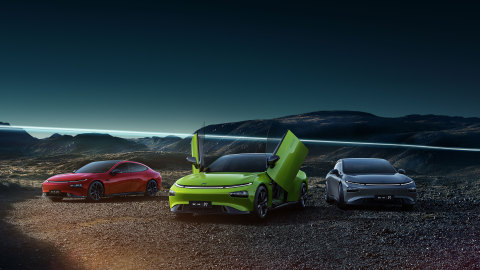Xpeng Announces Next-gen Autonomous Driving Architecture at Auto Guangzhou 2020
First auto maker to implement Lidar technology in 2021 production models
GUANGZHOU, China–(BUSINESS WIRE)–
Xpeng Inc. (“Xpeng” or the “Company”, NYSE: XPEV), a leading Chinese smart electric vehicle (“Smart EV”) company, today announced its next-generation autonomous driving architecture at Auto Guangzhou 2020.
This press release features multimedia. View the full release here: https://www.businesswire.com/news/home/20201119006399/en/

Xpeng P7 Smart Sports Sedan (Photo: Business Wire)
Xpeng has significantly upgraded its autonomous driving software and hardware systems for the 2021 production models. The Company has become the first car manufacturer to adopt Lidar (laser for imaging, detection and ranging) as a new hardware component for its next-generation autonomous driving architecture, significantly improving the vehicle’s high-precision object recognition performance.
“Introducing Lidar technology into production vehicles is a breakthrough in popularizing autonomous driving, and an endorsement of our in-house R&D process. Our customers will benefit from this premium advanced technology, which makes autonomous driving more driver-friendly, safe and effective,” said He Xiaopeng, Chairman & CEO of Xpeng.
The new hardware architecture is a combination of high-definition (HD) cameras, millimeter-wave radars, ultrasonic sensors, Lidar, high-precision positioning and mapping systems, all powered by a high-performance computing platform. Equipped with a total of 32 sensors, the system provides the strongest hardware redundancy, effectively avoiding single-system failure to deliver enhanced safety protection. It will also cover more usage scenarios, effectively enabling Xpeng vehicles to perform low-speed Navigation Guided Pilot (NGP) functions for city driving.
The software architecture is based on a full-stack of in-house-developed technologies, consisting of multiple modules: perception, behavior planning, behavior/motion prediction and map fusion, among others, forming a fully closed loop of data and algorithms to support rapid functional iteration.
This next-generation autonomous driving architecture will deliver major enhancements, including:
Enhanced integrated control unit
The XPU autonomous driving intelligent control unit integrates vehicle control and parking functions, making decision-making and execution more efficient. At the same time, by streamlining the number of controllers and wiring harnesses, the weight of the system is reduced.
Improved high-precision positioning
The real-time kinematic (RTK) terminal is upgraded from 4G to 5G, supporting precise positioning with high-precision maps for high-speed roads as well as urban roads. A new positioning scheme (IMU+GNSS+RTK (5G) with high-precision maps for both highways and city roads is adopted to achieve centimeter-level accuracy. With pinpoint positioning, latency reduced to milliseconds, and a driving scenario coverage rate of over 97.5%, the scheme provides high robustness, covering a wide range of terrain, high-rise buildings and underground parking-lot occlusion scenarios.
Enhanced perception fusion
The adoption of Lidar technology will significantly improve the accuracy of horizontal and vertical position identification, and spatial resolution (super high resolution <0.1°), while offering a perception capability that is unaffected by ambient light. Through the fusion of vision + millimeter wave radar + ultrasonic sensor + Lidar, the system’s performance in target detection and measurement resolution, is significantly improved even in scenarios without sufficient lighting, delivering near-perfect perception performance.
Computing power to increase
The high-performance computing platform will also be significantly upgraded from 30 TOPS to over 200 TOPS in the future, delivering a nearly tenfold increase in computing power from ten trillion times per second to several hundred trillion times per second. The system is designed with the capacity to further increase computing power, supporting the implementation of even higher-level autonomous driving functions.
The next-generation autonomous driving architecture will achieve an advanced level of navigation-guided autonomous driving, with wide coverage of different road conditions, low manual takeover rates, and longer continuous autonomous driving times. The new system also covers multiple weather conditions and situations for city and highway driving, including urban congestion, expressways, underground parking lots, toll gates, tunnels and night driving conditions.
About XPeng
XPeng Inc. (NYSE: XPEV) is a leading Chinese smart electric vehicle company that designs, develops, manufactures, and markets Smart EVs that appeal to the large and growing base of technology-savvy middle-class consumers in China. Its mission is to drive Smart EV transformation with technology and data, shaping the mobility experience of the future. In order to optimize its customers’ mobility experience, XPeng develops in-house its full-stack autonomous driving technology and in-car intelligent operating system, as well as core vehicle systems including powertrain and the electrification/electronic architecture. XPeng is headquartered in Guangzhou, China, with offices in Beijing, Shanghai, Silicon Valley, and San Diego. The Company’s Smart EVs are manufactured at plants in Zhaoqing and Zhengzhou, located in Guangdong and Henan provinces, respectively. For more information, please visit https://en.xiaopeng.com.
View source version on businesswire.com: https://www.businesswire.com/news/home/20201119006399/en/
For Media Enquiries:
Marie Cheung
XPeng Inc.
Tel: +852 9750 5170 / +86 1550 7577 546
E-mail: [email protected]
KEYWORDS: China Asia Pacific
INDUSTRY KEYWORDS: Data Management Automotive Manufacturing Consumer Electronics Automotive Technology Manufacturing Luxury Retail Software Performance & Special Interest Hardware
MEDIA:
| Photo |
 |
| Xpeng P7 Smart Sports Sedan (Photo: Business Wire) |
